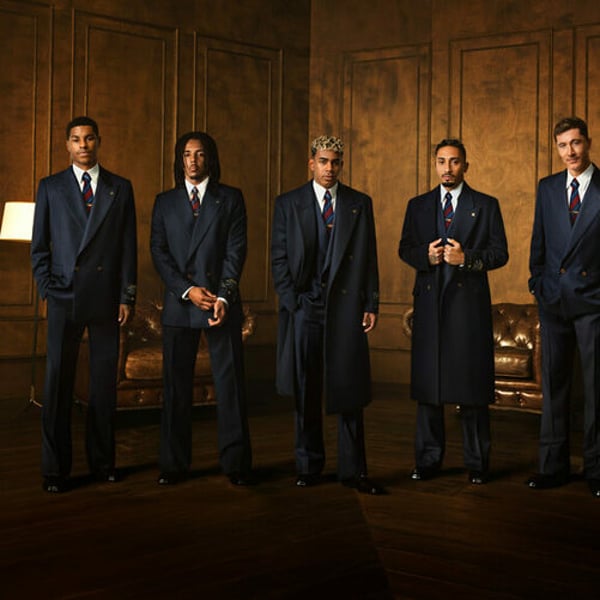Fashion
Amiri named formalwear partner of FC Barcelona

Published
November 3, 2025
Los Angeles-based fashion house Amiri is to design the formal wear of FC Barcelona – the current Spanish Liga 1 champions, and one of the most decorated clubs in the soccer world.
The winner of a record 80 domestic trophies, and of 23 European and worldwide titles, Barcelona is one of the most glamorous clubs on the planet. Its players have won the Ballon d’Or, the most prestigious individual prize in association football, the most for any professional team. Including 12 times for male players – like soccer legends Lionel Messi and Johan Cruyff – and three times for women players.
“The Amiri x FC Barcelona partnership begins with the 2024/2025 season, marking the start of an ongoing collaboration between Amiri and FC Barcelona. Both sides view it as a long-term relationship — one rooted in shared values of innovation, craftsmanship, and global excellence,” Amiri told FashionNetwork.com.
Founded in 2014 by Mike Amiri, a Beverly Hills High School graduate, the brand Amiri began specializing in stage outfits for musicians in California, before developing a first capsule collection.
By 2018, Amiri began staging runway shows during the Paris menswear season. One year later, Renzo Rosso’s OTB took a minority stake in the LA brand.
By 2020, Amiri had opened its first flagship on Rodeo Drive, Beverly Hills, while Amiri was nominated four times for Menswear Designer of the Year at the annual CFDA Awards in New York.
Today, Amiri boasts a network of 31 boutiques, and retails in over 150 sales points in the U.S., Europe, Gulf and Asia.
The linkup with Barcelona, “marks the first partnership of its kind for Amiri, uniting with a global icon in sport, and bringing a distinctly Hollywood vision of modern luxury to one of the world’s most celebrated football institutions,” the brand noted.
This partnership also unites a 21st-century label and a club with 125 years of history, respecting tradition and heritage.
The brand will provide FC Barcelona custom suiting for all players, across both their men’s and women’s teams, alongside club executives and leadership.
“The tailoring created for FC Barcelona is exclusive to the club and will not be available for public sale. Each piece was made-to-measure for the players and staff, combining Amiri’s signature relaxed Californian tailoring with nods to the club’s heritage through custom pinstripe fabrics and deep navy tones,” Amiri told FashionNetwork.com.
Inspiration is drawn directly from the colors of the players’ strip. Dressed in rich blue and garnet for over a century, the club is also known as equip blaugrana – the blue and garnet team. Marrying signature Amiri style with the distinct identity of FC Barcelona, for the Winter season Amiri uses the club’s deep navy blue as the primary shade on precisely tailored wool six-button overcoats, as well as tailored jackets – double-breasted for men, single-breasted for women – and gently flared trousers in a fine white-on-navy pinstripe wool.
For summer tailoring, pinstripe also appears on a new shirt-collar classic blouson, an iconic Amiri style inspired by sportswear, translated to formalwear, and here returned to sports, detailed with MA Monogram embroidery on the breast pocket.
Lightweight, sports-silhouette knits with contrast MA Monogram and tonal FC Barcelona embroidery round out the wardrobe for summer, while for winter pinstripe poplin shirts are teamed with a garnet and blue-striped tie and gold bar tie clip.
Copyright © 2025 FashionNetwork.com All rights reserved.
Fashion
Nigeria’s textile imports up 47.43% YoY in Jan-Sept 2025

The country imported textile and textile materials worth N 228.83 billion in the first quarter (Q1) this year, N 337.12 billion in Q2 and N 248.32 billion in Q3.
Industry experts blame policy failure, weak execution of credit initiatives, abandonment of promised institutional reforms, pervasive corruption and structural bottlenecks like weak cotton farming, insecurity and the inability to scale locally-produced polyester for the decline, according to Nigerian media reports.
Nigeria’s textile imports rose to N 814.27 billion in January-September 2025—a 47.43-per cent YoY rise despite repeated government claims of the sector’s revival.
Rising imports indicate a weak domestic textile industry.
Industry experts blame policy failure, weak execution of credit initiatives, abandonment of promised institutional reforms, pervasive corruption and structural bottlenecks for the fall.
Hamma Kwajaffa, director general of the Nigerian Textile Manufacturers Association, lamented that the 10-per cent tax on imported textiles—which was introduced when the ban on textile imports was lifted so that the amount collected can be ploughed into domestic textile production—has not been directed to improve the private textile sector.
Kwajaffa pointed to the failure to create a dedicated textile development fund domiciled with the Bank of Industry.
Conflicting positions among top officials had stalled any action related to the sector and repeated workshops and announcements without execution had yielded no tangible outcome, Kwajaffa added.
Fibre2Fashion News Desk (DS)
Fashion
CFDA to implement fur ban at NYFW from September 2026
Fashion
ECB keeps interest rates unchanged, upgrades growth outlook

According to updated Eurosystem staff projections, headline inflation is expected to average 2.1 per cent in 2025, easing to 1.9 per cent in 2026 and 1.8 per cent in 2027, before returning to 2.0 per cent in 2028. Inflation excluding energy and food is forecast at 2.4 per cent in 2025, gradually declining to 2.0 per cent by 2028. Inflation for 2026 has been revised upward, mainly due to expectations that services inflation will fall more slowly than previously anticipated, the Governing Council of the ECB said in a press release.
European Central Bank has kept its key interest rates unchanged, maintaining confidence that inflation will stabilise at the 2 per cent target.
Updated projections show inflation easing gradually over the coming years, with a slight upward revision for 2026 due to persistent services prices.
Economic growth forecasts have been revised higher, supported by stronger domestic demand.
The ECB also revised its economic growth outlook higher compared with its September projections. Growth is now expected to reach 1.4 per cent in 2025, 1.2 per cent in 2026 and 1.4 per cent in 2027, with expansion projected to remain at 1.4 per cent in 2028. The improvement is driven largely by stronger domestic demand across the euro area.
The Council reiterated its commitment to ensuring that inflation stabilises sustainably at the 2 per cent target. It emphasised that future monetary policy decisions will remain data-dependent and assessed on a meeting-by-meeting basis, without pre-committing to any specific interest rate path.
Fibre2Fashion News Desk (KD)
-

 Business6 days ago
Business6 days agoHitting The ‘High Notes’ In Ties: Nepal Set To Lift Ban On Indian Bills Above ₹100
-

 Politics1 week ago
Politics1 week agoTrump launches gold card programme for expedited visas with a $1m price tag
-

 Business1 week ago
Business1 week agoRivian turns to AI, autonomy to woo investors as EV sales stall
-

 Sports1 week ago
Sports1 week agoU.S. House passes bill to combat stadium drones
-

 Sports1 week ago
Sports1 week agoPolice detain Michigan head football coach Sherrone Moore after firing, salacious details emerge: report
-

 Fashion1 week ago
Fashion1 week agoTommy Hilfiger appoints Sergio Pérez as global menswear ambassador
-

 Business1 week ago
Business1 week agoCoca-Cola taps COO Henrique Braun to replace James Quincey as CEO in 2026
-

 Tech1 week ago
Tech1 week agoGoogle DeepMind partners with UK government to deliver AI | Computer Weekly



















